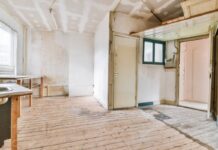Oooh, 3.5 bedrooms and I love the kitchen! I’ve seen everything I need to see – sell it to me now! It’s fun to be the newbie at the open home, wide-eyed and excited by all the possibilities. And completely blind to all the issues. Before you fall in love with the property, tick a few of the less obvious problems off your open home checklist.
First Home Buyers
The couple buying their second home, or an investment property, they know EXACTLY how much it’s going to cost to renovate the property. They know what it’s going to cost to repair the obvious issue in the bathroom waterproofing – because they’ve been through it before. They’ve seen how quickly a cheap and cheerful renovation project can turn into a money trap. If you’re worried about being the newest buyer in the room, you can download a first home buyers guide free or check out this article.
The Neighbourhood
First, are they your people? You have kids? You want local kids to occupy your kids. Do the neighbours appear friendly? Is there street parking? Is the neighbourhood well cared for? Nothing worse than buying into a street full of grubs and party people.
Fences and excessive security
Look around, if all your potential new neighbours have hard-core security measures, high fences, cameras, and window grills, you might be buying into a high-crime street. Even if the suburb is “pretty safe” it only takes one drug dealer on the block, or one gang of local brats to ruin the serenity.
Concrete and driveway red flags
Due to Queensland’s weather extremes it is not uncommon to find cracks and breaks in concrete pathways, driveways or paving. But, if there is evidence that concreted areas have been seriously disrupted in the past, it could tell a story of burst pipes or other problems underground.
Surface drainage
Poor drainage on your new property can lead to a multitude of long term building defects. Moisture retention can lead to the erosion of soil, which can then cause problems such as structural movement and damage. It is important to ensure stormwater drains away from your property efficiently and that there’s adequate backyard drainage. Similarly, if the owners have gone a little crazy on drainage, with pits and pumps and the like, you may wish to check the flood maps very carefully. Check the garden shed – if it’s full of sandbags, you might be in for flooding problems.
Trees and “Freebees”
Those gorgeous big trees could well be digging up the pipes and cracking the foundations. You’ll need to check where the pipes run on the property because removing trees is way more expensive than you might guess. Freestanding structures including barbecues, garden sheds, gazebos, cubby houses and retaining walls are all welcome ‘bonuses” until they’re not. It might seem cool that the owners are happy to leave the cubby house behind, until you find out it’s full of rot and will cost you a bomb to remove.
OOooh it has fireplaces!
In Queensland? Wow, you’ll use them sooo much. They’re lovely, it’s lovely to have an open fire at home but chimneys need to be kept in good repair or can cause serious issues.
Garages and workshop spaces
Whether you choose to use your garage for storage, to park your car or as a work-shed, it is imperative to analyse its condition. Who knows what the previous owner used it for? Parking a car, lifting weights or cooking meth? Who knows! So, take a good look at the walls and floors for signs including:
- an increased amount of cracking and deterioration in the concrete slab;
- moisture penetration in the concrete slab;
- damage to internal lining; and
- the operating mechanics of the garage door.
Wait, is that….cladding?
Take a good close look at the exterior of the home, is it, what it appears to be? Queensland loved a bit of cladding back in the day and it wasn’t so long ago that fake brick and stone panels were all the rage. What is the building made from? Was it originally clad out of a love for all things cheesy or is the cladding a cheap and cheerful way to hide a whole lot of asbestos? Is it solid brick or brick veneer? How’s the brickwork? Any signs of mortar erosion? Rot? Damp? Insect infestation? If it’s timber, is it in good nick? Replacing timber is quite a costly exercise!
Roof, guttering, ceilings
It’s an open home, so you probably won’t get the chance to have a crawl around in the ceiling but you can take a look at the state of the roof and guttering. Is there excess mould on gutters and downpipes that could indicate problems? Is the roof newly painted? If so, do neighbouring roofs offer any insight into what it looked like before? Are there any waterstains on the ceilings that could be signs of roof problems? Can you see a manhole? You’ll need to leave the finer points to the inspection day, but a big waving red flag is worth noting on your open home checklist. Learn more about what could be going on up there here.
House interior
This is where the sellers have invested most of their “staging” budget. They want you to fall in love with the property so they’ve dressed it in its “Sunday Best”. Look beyond the staged furniture and chic window dressings, look beyond a new layer of paint. Take a good hard look at the details inside each room.
- mold, damp and evidence of water penetration in wet areas (don’t forget the laundry!)
- roof leaks;
- springy, squeeky or spongy floors
- evidence of pest infestation;
- cracks in the walls;
- defective fixings;
- paint blistering;
- loose, broken or springy floor boards and carpet wear;
- door hinges, alignment, and disrepair;
- cracked glass and decay around windows; and
- fly screen damage.
Decks and outdoor living areas
Outside living areas are easy to overlook because you’re focused on the potential lifestyle benefits, and like a lot of newbie buyers, dismissive of the area. It’s just an add on. It’s not in the house, right? But, wow I want to put an outdoor kitchen here, and a cool sofa and a rug…. Before you get lost in the possibilities, take a look at the decking, is it in good shape? Is the deck “square” to the house? Is its foundations in good shape? Decks get hammered by the weather. If they’re in poor condition or were installed badly, they can be terribly dangerous. Check the deck!
Gribblies, bities and gross things
There doesn’t have to be a rat running by to tell you that rats have been there. Check around the edge of the property for pest control devices like bait boxes. If there’s one or two, well great. If there’s 11, and more behind the fridge and some in the front yard, lots newly installed – there might be a history here. Similarly, if wood appears soft or porous, if there’s little piles of grit around, if there’s an excessive number of cockroaches baits – or if the seller’s agent is burning scented candles in every room, you should raise this with your pest inspector.
Crawlspace
The underfloor of your property is considered the supports of your home; the retaining walls, stumps, and foundation walls. While you probably won’t be able to get under the house at the open home, take a good look at what is there.
Look for:
- decay of the stumps (what to look for);
- evidence of movement;
- cracking in concrete or “concrete cancer”
- deterioration of bearers and joists;
- evidence of pest infestation;
- asbestos
- “random junk” under the house that will soon be your random junk. (If it’s big bags of asbestos, then your dumping bill could be steep!)
- damage to concrete slab;
- moisture penetration;
- damage to flooring;
- the correct installation of ant caps, (the what?)
When your open-home checklist looks more like an essay
At the end of the open home, your checklist looks like a dissertation. Perhaps you spotted everything wrong with the property, perhaps you’ve barely scratched the surface. If you have found numerous issues with the property, express your concerns to the agent.
If you do put in an offer, pay the minimum deposit and book your inspections during the cooling off period. If your building report is concerning, you have plenty of time to back out of the contract, or get tradies in to quote the repairs. Perhaps you’ll even have time to renegotiate your offer and get yourself a nice discount.





